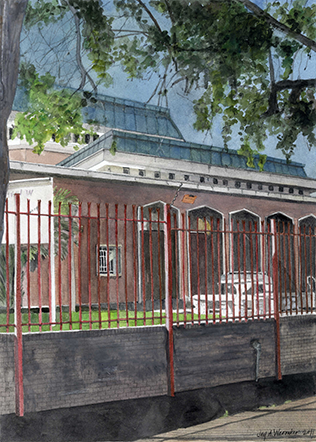 Exterior View (2005), 15” x 11” Watercolor, Jay A. Waronker
Exterior View (2005), 15” x 11” Watercolor, Jay A. Waronker
south africa
Former Synagogue (Dating to the 1940s) |
|
|
Jews, mostly of German origin, first settled in the Free State of central South Africa, in what was then called the Orange River Sovereignty, in the 1840s. At that time, the Jews became part of the Sovereignty’s overall white population that did not exceed 4,000 people. In 1855, the Orange River Sovereignty became the Orange Free State, and during that period it was common to find at least one or two German Jewish families living in nearly every hamlet of the state. This small and dispersed Jewish community controlled a sizable portion of the trade of the state. In 1871, an annual Yom Kippur service was instituted in the home of a Jew living in Bloemfontein, the capital of the Orange Free State. Also in 1871, the first Jewish funeral was held in the Orange Free State, and two years later marriages by Jewish rites were legalized.
The small Jewish population that numbered forty-one people by the end of the 1870s grew in the 1880s and early 1890s to include new arrivals from Eastern Europe. By 1890, with one hundred fifty Jews living in Bloemfontein, a congregation was formally established. A rabbi from Kimberly, South Africa came to town on a rotating basis to officiate over events and lead prayer services. During the period, the Jews of Bloemfontein used the Free Mason’s Building for prayer services, and later they shifted to private homes or rented halls.
At the turn of the century, land for the building of a proper synagogue was purchase by the local Jews for the building of their first synagogue. Around that time Bloemfontein’s Jewish population numbered several hundred people. Construction on the synagogue began in 1903, and the building was consecrated in March 1904. Among those attending the dedication ceremony was the lieutenant-governor; the executive council, and the justices of the Free Orange State. This building continued to serve the congregation until the 1940s when the far larger structure rendered here was constructed on a new site immediately to the north of the city center. It was realized to serve a congregation that is estimated to have approached 1,600 members. Its design with its mostly solid brick walls, small clerestory windows, and copper roof, seems to recall some of the work of American architect Frank Lloyd Wright in its massing, horizontal proportions, use of materials, and stylized details.
In the 1960s, Jews wishing to embrace the Progressive Movement broke away from their fellow Orthodox members and establish their own congregation. Within a short time, the Progressive Jews built their own synagogue, and the Orthodox Jews continued to base themselves out of this in-town building for the next three decades. Today the building remains standing, although it was sold by the Orthodox Jews in the early 1990s to the Seventh Day Adventist Church, who still own and maintain the property and use it for religious needs and public forums. At that time, as a result of the uncertain conditions of post-apartheid South Africa, many White South Africans that included Jews emigrated. With its congregation much declined, the large building was no longer needed, and the Orthodox Jews purchased the synagogue realized in 1964by then defunct Progressive Jewish community. After retrofitting this space to serve their needs, the Orthodox Jews began using that synagogue.
